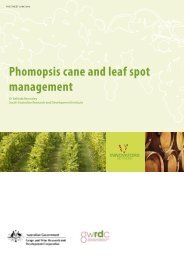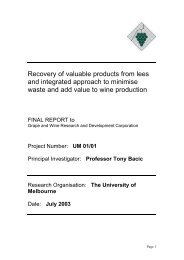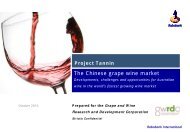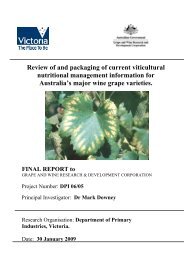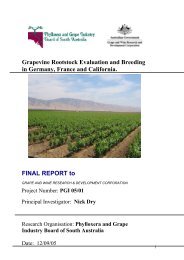Identification of the major drivers of 'phenolic' taste in ... - GWRDC
Identification of the major drivers of 'phenolic' taste in ... - GWRDC
Identification of the major drivers of 'phenolic' taste in ... - GWRDC
You also want an ePaper? Increase the reach of your titles
YUMPU automatically turns print PDFs into web optimized ePapers that Google loves.
AWRI: <strong>Identification</strong> Of The Major Drivers Of ‘Phenolic’ Taste In White W<strong>in</strong>es<br />
3 Do Different Phenolic Pr<strong>of</strong>iles Affect<br />
<strong>the</strong> Taste Pr<strong>of</strong>iles <strong>of</strong> White W<strong>in</strong>es?<br />
3.1 Introduction<br />
It has been established <strong>in</strong> an Australian scenario that overall ‘phenolic <strong>taste</strong>’ amongst Australian w<strong>in</strong>es<br />
can be dist<strong>in</strong>guished, at least by highly experienced w<strong>in</strong>e assessors (Chapter 2). However, <strong>the</strong> diversity <strong>of</strong><br />
varieties and w<strong>in</strong>emak<strong>in</strong>g styles is known to result <strong>in</strong> w<strong>in</strong>es with differ<strong>in</strong>g amounts and types <strong>of</strong> phenolics<br />
i.e. different ‘phenolic pr<strong>of</strong>iles’. It rema<strong>in</strong>s to be established whe<strong>the</strong>r, and <strong>in</strong> what ways, <strong>the</strong>se different<br />
w<strong>in</strong>e phenolic pr<strong>of</strong>iles might <strong>in</strong>fluence phenolic <strong>taste</strong>s. In order to study this, whole phenolic fractions <strong>of</strong><br />
differ<strong>in</strong>g phenolic composition were first isolated from commercial w<strong>in</strong>e and characterised by HPLC. The<br />
whole phenolic fractions were <strong>the</strong>n added to two commercial w<strong>in</strong>es after which <strong>the</strong>ir phenolic <strong>taste</strong><br />
pr<strong>of</strong>iles were quantified by a tra<strong>in</strong>ed sensory panel. W<strong>in</strong>es created from a diversity <strong>of</strong> varieties and<br />
w<strong>in</strong>emak<strong>in</strong>g styles <strong>in</strong>herently have a range <strong>of</strong> different basic composition. Alcohol concentration can vary<br />
greatly and can be highly <strong>in</strong>fluential <strong>in</strong> <strong>the</strong> perception <strong>of</strong> phenolic <strong>taste</strong>s (see Chapter 5) and as such, its<br />
<strong>in</strong>fluence was also <strong>in</strong>vestigated as a variable with <strong>the</strong>se whole phenolic fractions.<br />
3.2 Methods<br />
3.2.1 Sample Preparation<br />
A current v<strong>in</strong>tage commercial Riesl<strong>in</strong>g and unwooded Chardonnay were used as base w<strong>in</strong>es. Whole<br />
phenolics were extracted from ano<strong>the</strong>r three w<strong>in</strong>es that were deemed by a panel <strong>of</strong> experienced <strong>taste</strong>rs to<br />
exhibit phenolic <strong>taste</strong>s. They were a McLaren Vale Fiano, a Canberra District Viognier and an Alsatian<br />
Gewurztram<strong>in</strong>er. The whole phenolics from <strong>the</strong>se w<strong>in</strong>es were eluted <strong>of</strong>f Amberlite FPX66 res<strong>in</strong> us<strong>in</strong>g<br />
96% ethanol, <strong>the</strong> ethanol evaporated under vacuum and redissolved <strong>in</strong> water and freeze dried. All samples<br />
<strong>of</strong> whole phenolics were kept at -80°C before use.<br />
Whole phenolics were extracted from a volume <strong>of</strong> w<strong>in</strong>e as described above and <strong>the</strong>n 50% <strong>of</strong> <strong>the</strong> whole<br />
phenolics that were collected were added back to <strong>the</strong> same volume <strong>of</strong> base w<strong>in</strong>e just prior to tast<strong>in</strong>g. An<br />
additional treatment factor <strong>of</strong> an additional 1% ethanol v/v (96%, Tarac Industries, SA) was <strong>in</strong>cluded to<br />
assess <strong>the</strong> effect <strong>of</strong> alcohol concentration on <strong>the</strong> perception <strong>of</strong> phenolic <strong>taste</strong>s. The whole phenolic<br />
fractions were analysed us<strong>in</strong>g <strong>the</strong> HPLC method described <strong>in</strong> Section A.3.<br />
Page | 25




